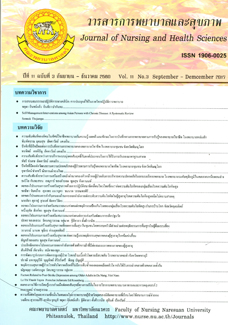ความพึงพอใจและความเชื่อมั่นในตนเองในการพยาบาลผู้ป่วยวิกฤตของนิสิตพยาบาล ที่เรียนโดยใช้สถานการณ์จำลอง
Main Article Content
บทคัดย่อ
การวิจัยครั้งนี้เป็นการวิจัยเชิงพรรณนา เพื่อศึกษาความพึงพอใจของนิสิตพยาบาลที่เรียนโดยใช้สถานการณ์ จำลองและเปรียบเทียบความเชื่อมั่นในตนเองในการพยาบาลผู้ป่วยวิกฤตของนิสิตพยาบาลก่อนและหลังเรียน โดยใช้สถานการณ์จำลอง กลุ่มตัวอย่างเป็นนิสิตพยาบาลชั้นปีที่ 3 จำนวน 86 คน เครื่องมือที่ใช้ในการวิจัยประกอบ ด้วยแบบวัดความพึงพอใจและแบบวัดความเชื่อมั่นในตนเองของนิสิตพยาบาลที่เรียนโดยใช้สถานการณ์จำลอง ตรวจสอบความตรงของเนื้อหาโดยผู้ทรงคุณวุฒิได้ค่าดัชนีความตรงตามเนื้อหาเท่ากับ .93 และ .95 ตามลำดับ และหาค่าความเที่ยงโดยใช้สูตรสัมประสิทธิ์แอลฟ่าของครอนบาคได้เท่ากับ .91 และ .96 ตามลำดับ วิเคราะห์ข้อมูล โดยใช้สถิติเชิงพรรณนา สถิติทดสอบทีที่ไม่เป็นอิสระต่อกัน (paired t-test) และสถิติวิลคอกซัน (Wilcoxon signed-ranks test) ผลการศึกษาพบว่า 1.ความพึงพอใจของนิสิตพยาบาลที่เรียนโดยใช้สถานการณ์จำลองอยู่ในระดับมาก ซึ่งมีค่าเฉลี่ย เท่ากับ 4.28 (S.D. = .48) 2.ความเชื่อมั่นในตนเองของนิสิตพยาบาลหลังเรียนโดยใช้สถานการณ์จำลองมีค่าเฉลี่ย ( = 4.36, S.D. = .50) สูงกว่าก่อนเรียน ( = 2.95, S.D. = .53) อย่างมีนัยสำคัญทางสถิติที่ระดับ .001 ผลการวิจัยนี้แสดงให้เห็นว่านิสิตพยาบาลมีความพึงพอใจต่อการเรียนโดยใช้สถานการณ์จำลองและ ควรจัดการเรียนโดยใช้สถานการณ์จำลองให้กับนิสิตพยาบาล เพื่อเพิ่มความเชื่อมั่นในตนเองในการพยาบาล ผู้ป่วยวิกฤตซึ่งจะส่งผลต่อการพัฒนาทักษะในการปฏิบัติการพยาบาลต่อไป
Article Details
เอกสารอ้างอิง
รายวิชาปฏิบัติการพยาบาลผู้ใหญ่ 2 หลักสูตร
พยาบาลศาสตรบัณฑิต. พิษณุโลก: คณะ
พยาบาลศาสตร มหาวิทยาลัยนเรศวร.
ทิศนา แขมมณี. (2557). ศาสตร์การสอน องค์ความรู้
เพื่อการจัดกระบวนการเรียนรู้ที่มีประสิทธิภาพ.
กรุงเทพฯ: สำนักพิมพแ์ หง่ จุฬาลงกรณม์ หาวิทยาลัย.
ผกามาศ พีธรากร และจินตนา ทองเพชร. (2551).
การพัฒนารูปแบบการจัดการเรียนการสอน
โดยใช้สถานการณ์จำลอง วิชาการดูแลรักษา
ผูบ้ าดเจ็บฉุกเฉิน นักศึกษาหลักสูตรประกาศนียบัตร
เวชกิจฉุกเฉิน วิทยาลัยพยาบาลพระจอมเกล้า
จังหวัดเพชรบุรี.รายงานการวิจัย. เพชรบุรี
วิทยาลัยพยาบาลพระจอมเกล้า.
พลพันธ์ บุญมาก และสุหัทยา บุญมาก. (2013). Medical
simulation the way to improve patient care.
Srinagarind Med. 28 (suppl): 80-85.
ภาควิชาการพยาบาลเด็ก ผู้ใหญ่และผู้สูงอายุ. (2015). การ
จัดการเรียนการสอนโดยใช้หุ่นมนุษย์จำลอง
(Stimulation-Based Learning: SBL). การจัดการความรู้
วิทยาลัยพยาบาลบรมราชชนนีสงขลา. สืบค้นเมื่อ
14 กันยายน 2558,จากhttp://www.bcnsk.ac.th/
km2/?p=42
Bandura, A. (1986). Social foundations of thought and
action: A social cognitive theory. New Jersey:
Prentice-Hall.
Bandura, A. (2004). Health promotion by social
cognitive means.Health Education and Behavior,
31(2): 143-164.
Cant, R. P., & Cooper, S. J. (2009). Simulation-based
learning in nurse education: systematic review.
Journal of Advanced Nursing, 66(1): 3-15.
Cato, M. L. (2013). Nursing student anxiety in simulation
setting: A mixed methods study. Dissertations
and Theses. Portland State University.
Chiang, V. C. L., & Chan, S. S. C. (2014). An evaluation
of advanced simulation in nursing: A mixedmethod
study. Collegian, 21: 257-265.
Hick, F. D., Coke, L., & Li, S. (2009). The effect of
high-fidelity simulation on nursing students’
knowledge and performance: A pilot study.
National Council of State Boards of Nursing,
40: 1-27.
Jeffries, P. R. (2005). A framework for designing
implementing and evaluating simulations used
as teaching strategies in nursing. Nursing
Education Perspectives, 26(2): 96-103.
Jeffries, P. R. (2007). Simulation in nursing education
from conceptualization to evaluation. New York:
National League for Nursing.
Jeffries, P. R. (2008). Getting in S.T.A.P. with
simulation: Simulations take educator
preparation. Nursing Education Perspectives,
29(2): 70-73.
Levett-Jones, T., McCoy, M., Lapkin, S., Noble, D.,
Hoffman, K., Dempsey, J.,…, & Roche, J.
(2011). The development and psychometric
testing of the satisfaction with simulation
experience scale. Nurse Education Today. Doi:
10.1016/j.nedt.2011.01.004.
O’Donnell, J. M., Decker, S., Howard, V., Levett-Jones,
T., & Miller, C. W. (2014). NLN/Jeffries
simulation framework state of the science
project: simulation learning outcomes. Clinical
Simulation in Nursing, 10(7): 373-382.
Smith, S. J., &Roehrs, C. J. (2009). High-fidelity
simulation: Factors correlated with nursing
student satisfaction and self-confidence. Nursing
Education Perspectives, 30(2): 74-78.
Todd, M., Manz, J. A., Hawkins, K. S., Parsons, M. E.,
& Hercinger, M. (2008).The development of a
quantitative evaluation tool for simulations
in nursing education. International Journal
of Nursing Education Scholarship, 5(1):
Retrieved September 14, 2015 from http://www.
Bepress.com/ijnes/vol5/iss/art41
White, K. A. (2014). Development and validation of
a tool to measure self-confidence and anxiety
in nursing students during clinical decision
making. Journal of Nursing Education, 53(1):
14-22.


